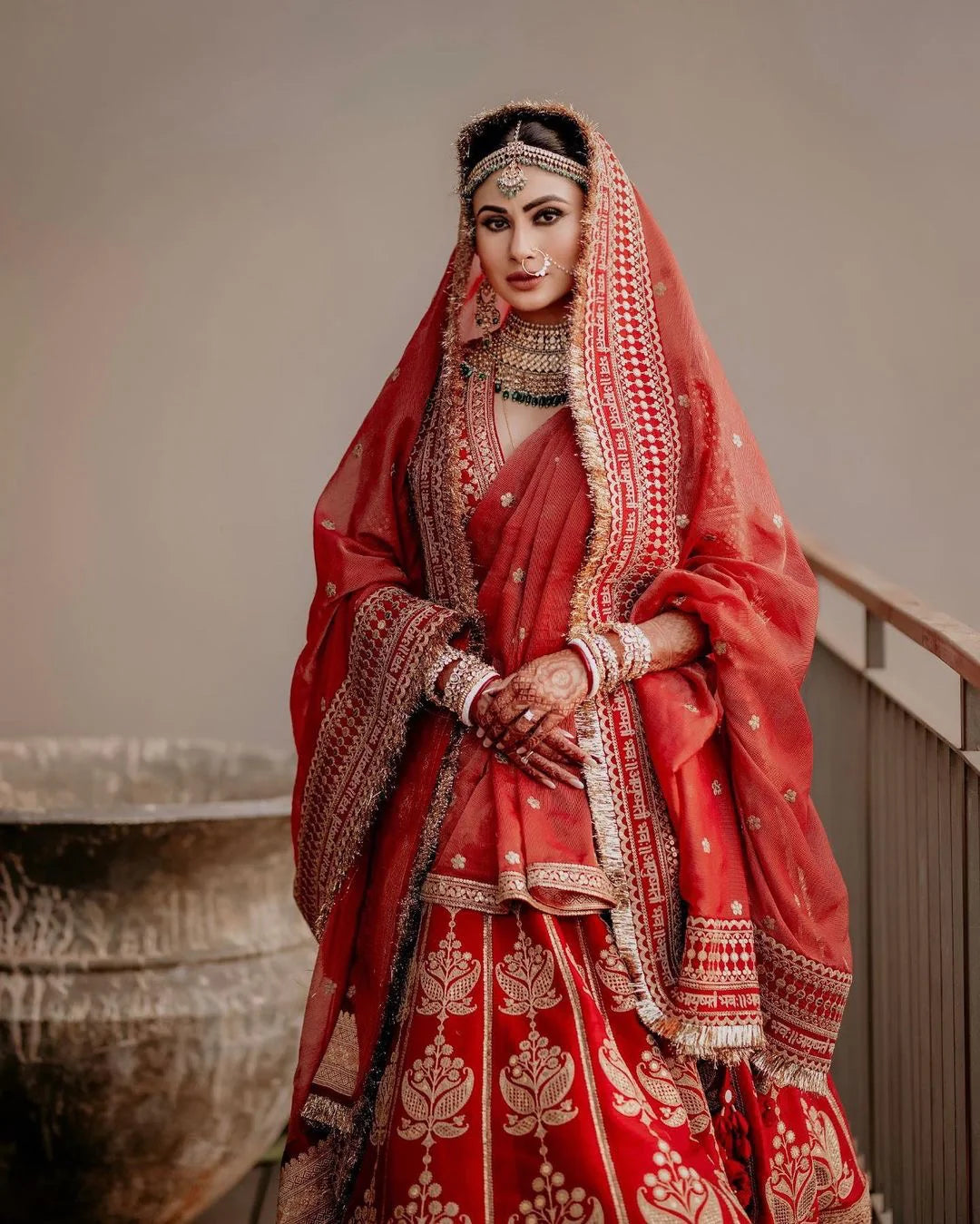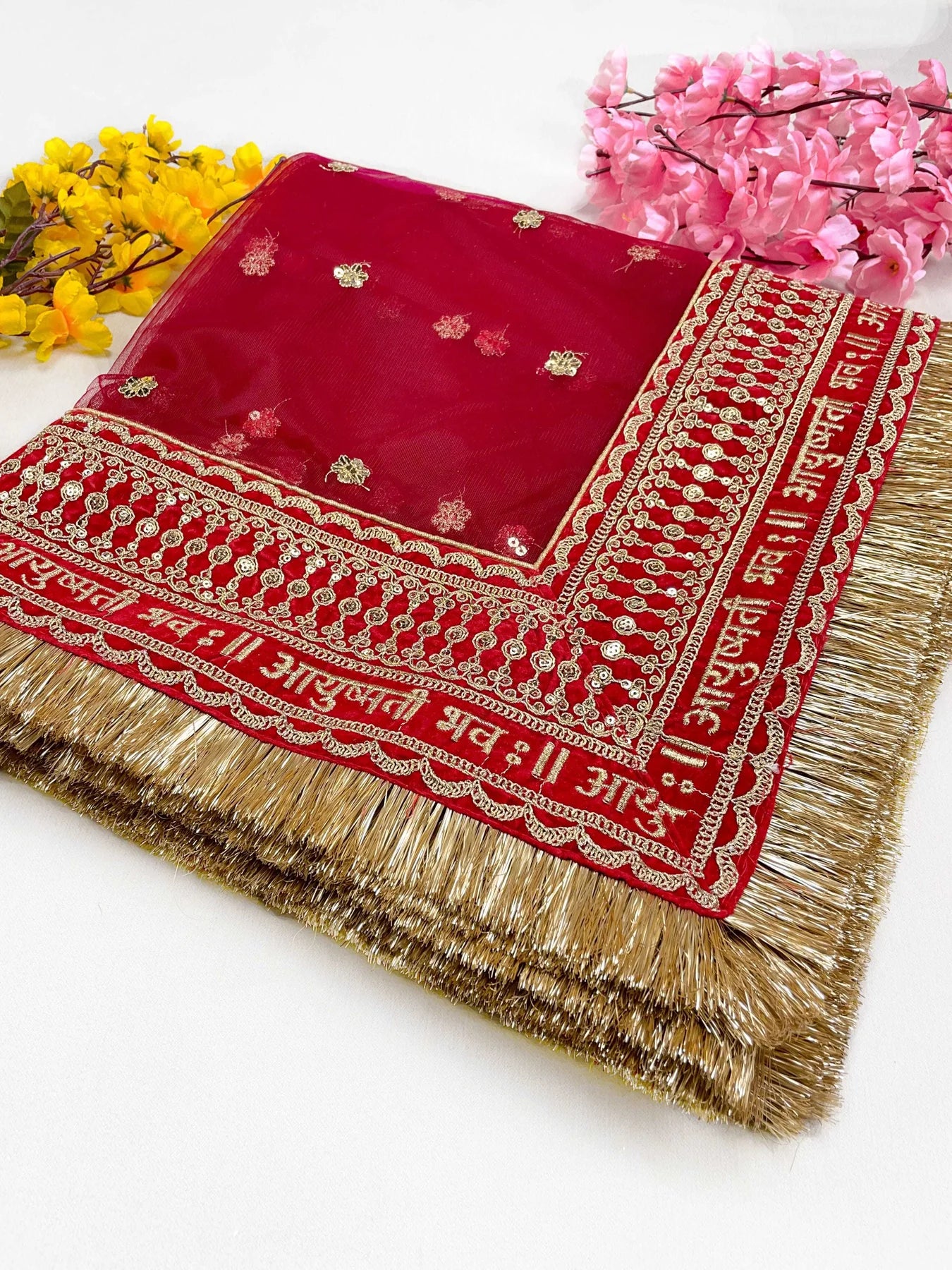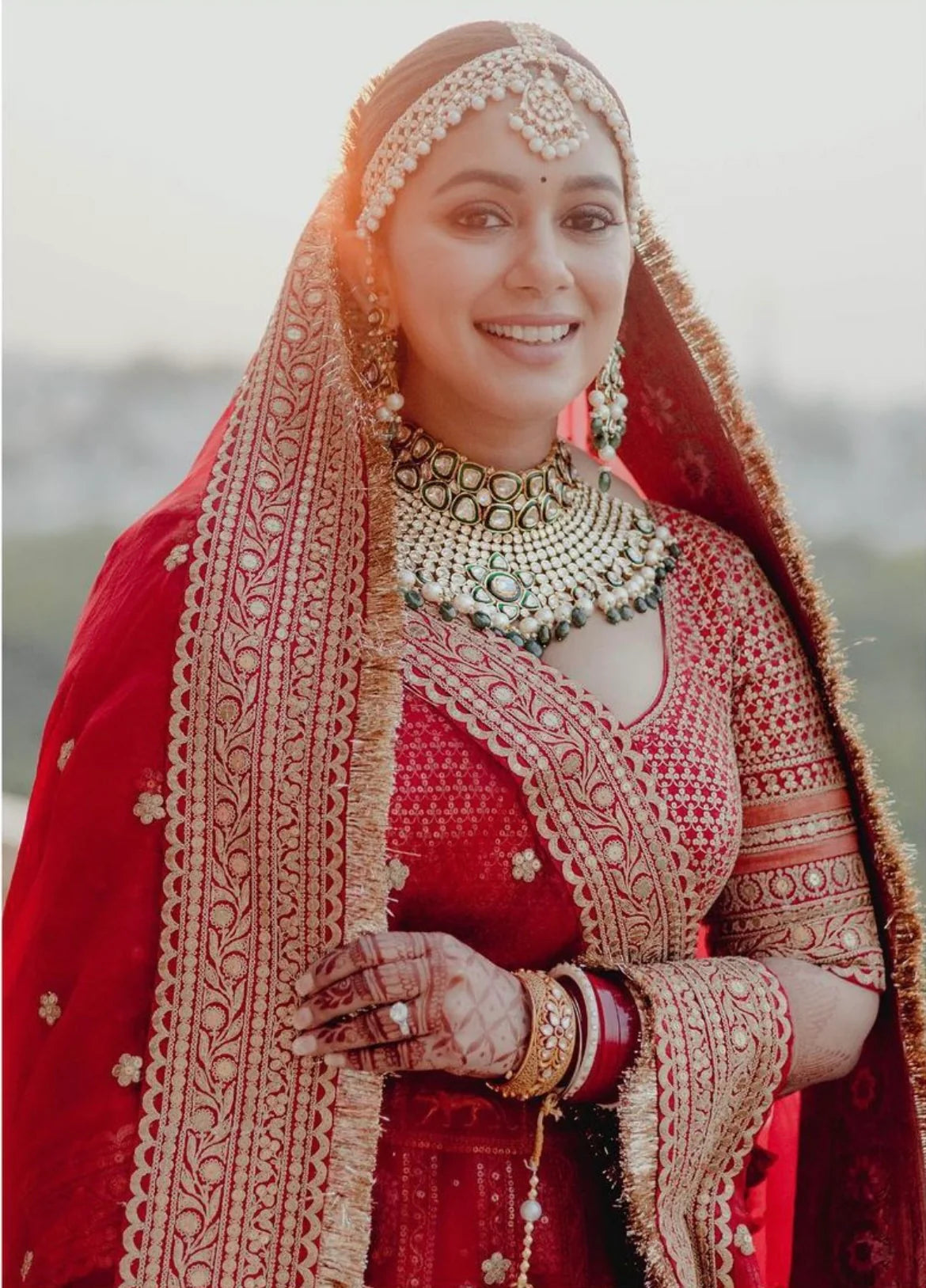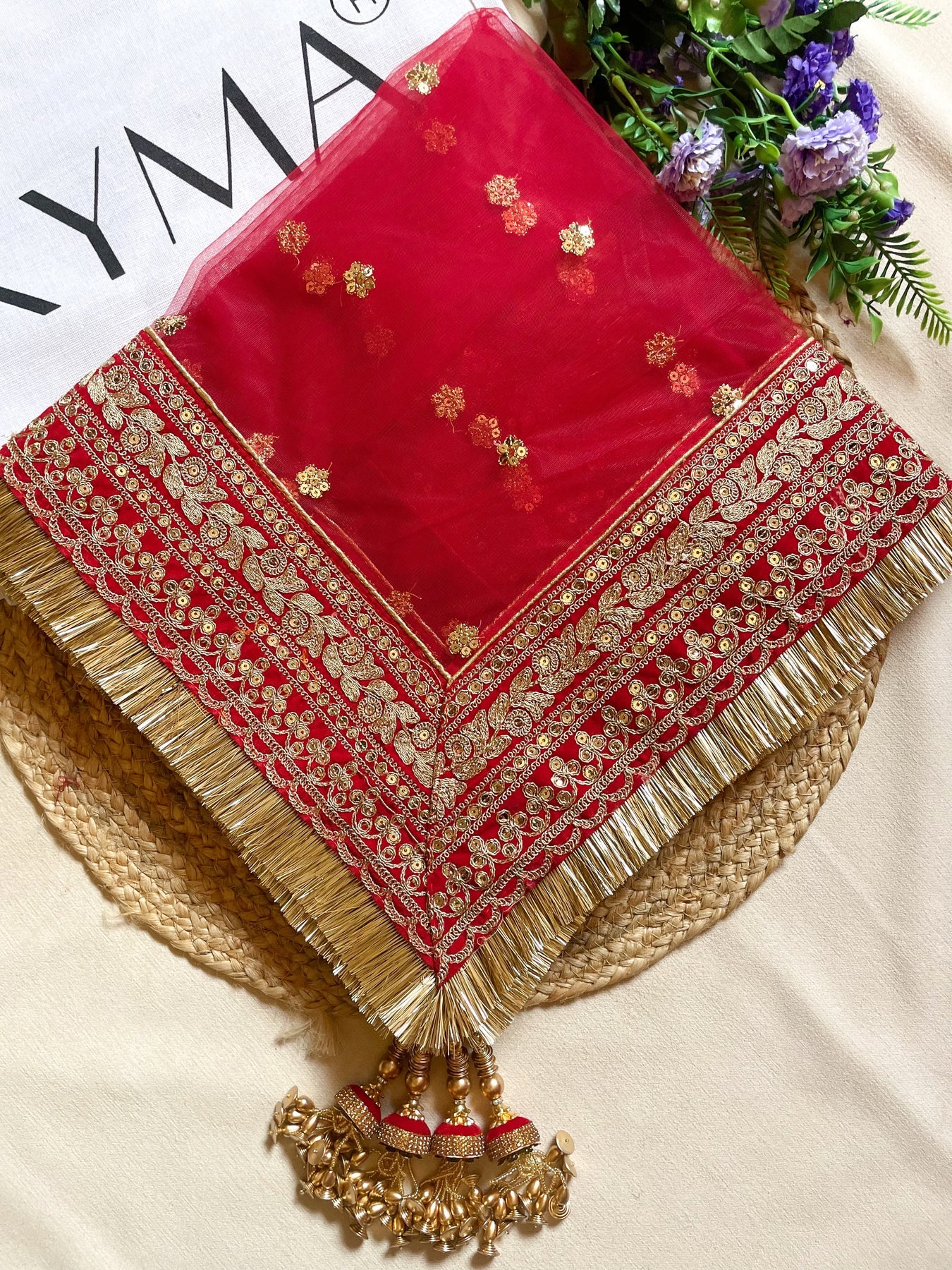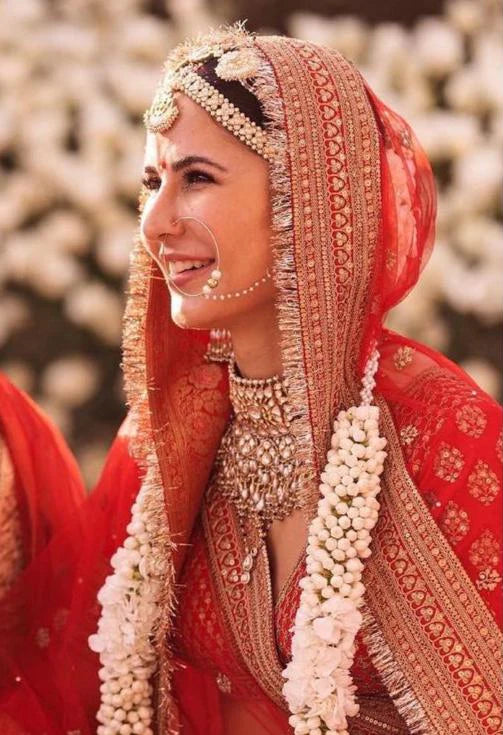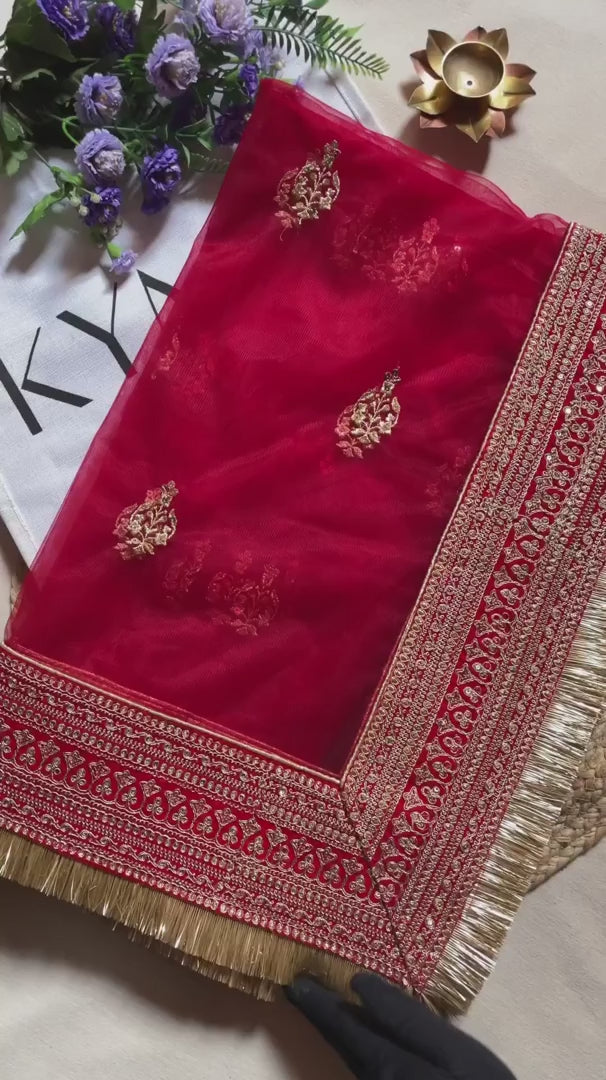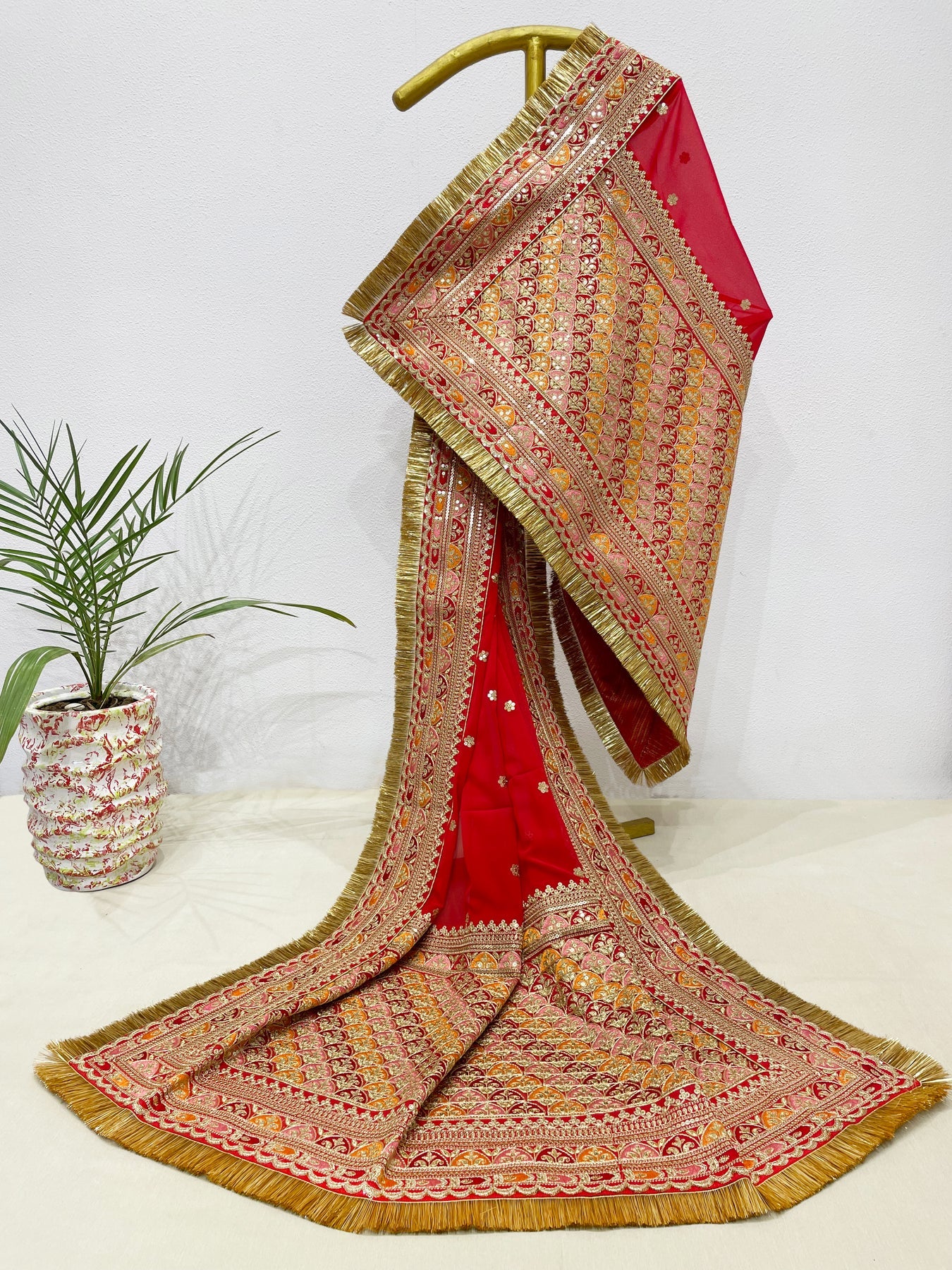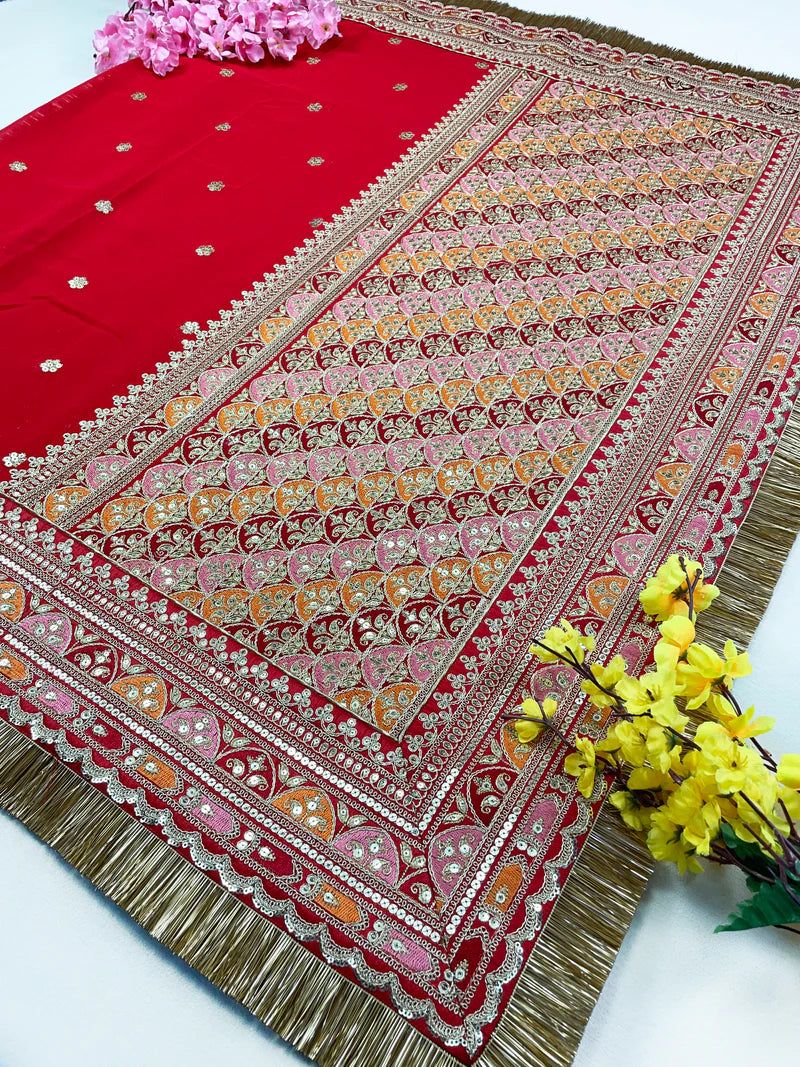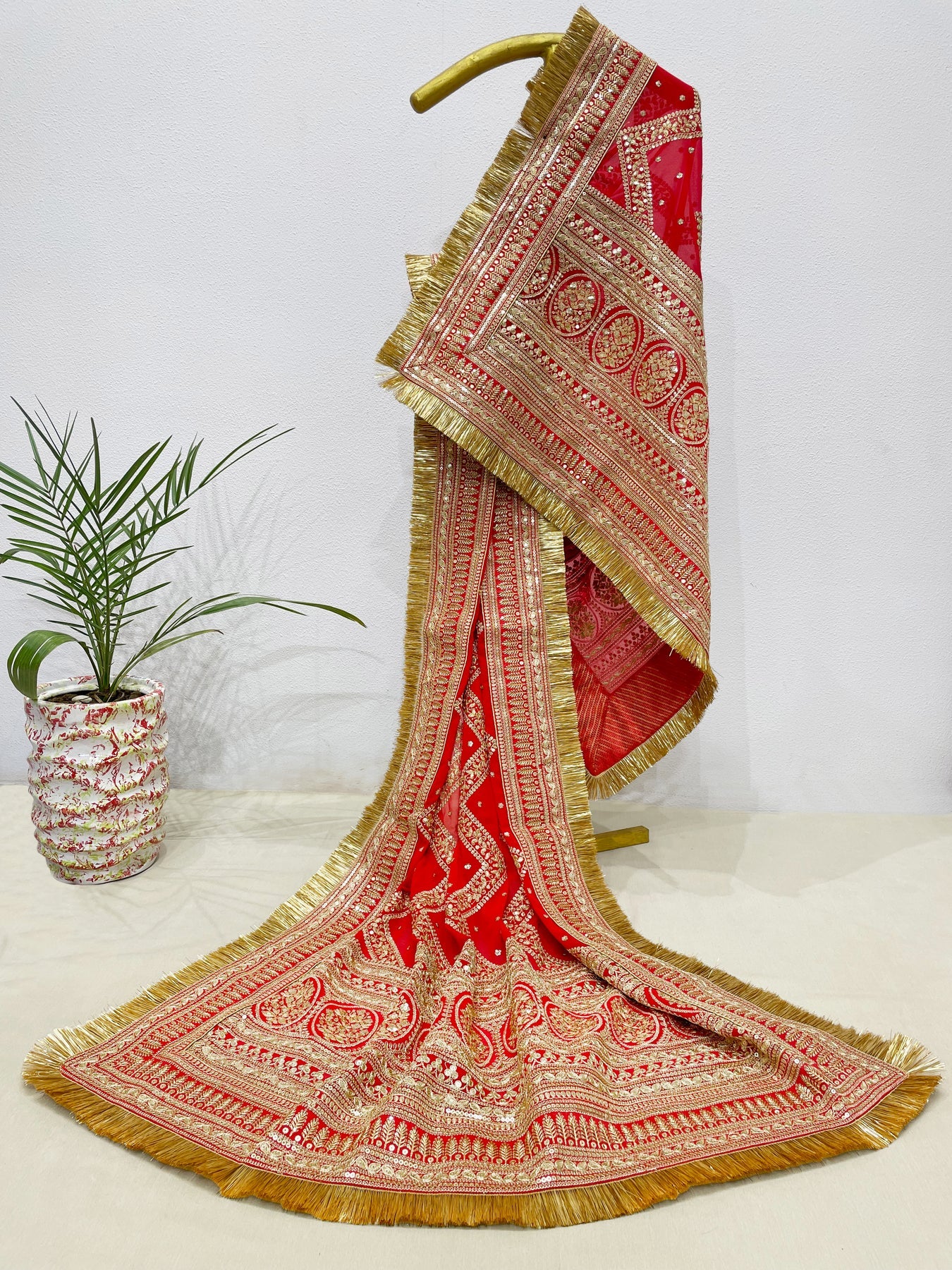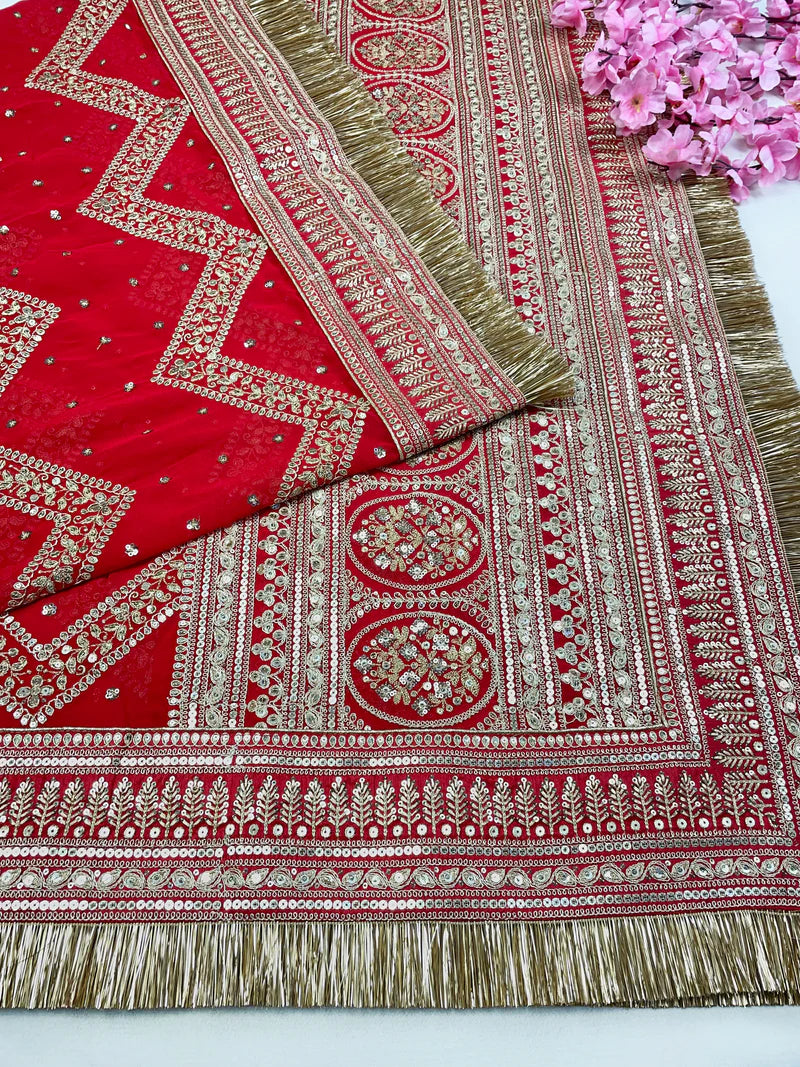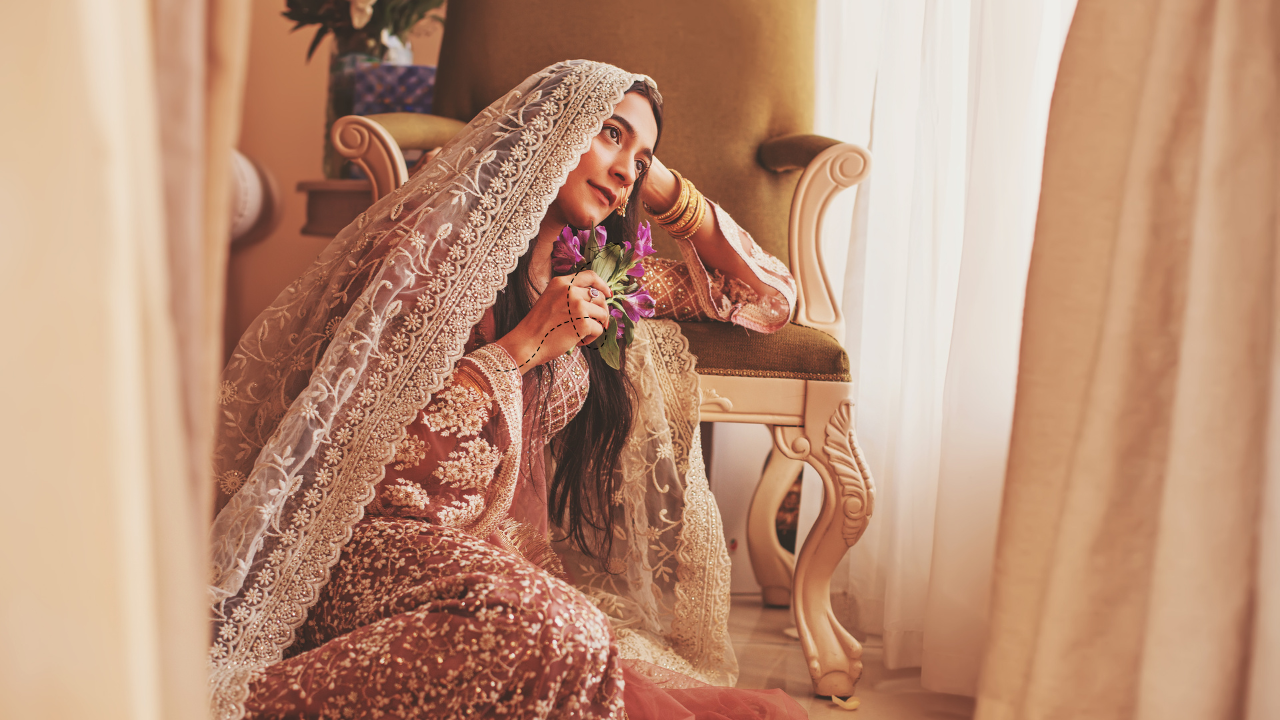
The Complete Guide to Bridal Dupattas: Styles, Trends, and the Significance of Saubhagyavati Bhavah
Introduction
In Indian weddings, every element of a bride’s attire holds deep meaning. While the lehenga, jewelry, and makeup often attract the most attention, the dupatta is the true crown of a bridal ensemble. Draped with grace, adorned with embroidery, and imbued with blessings, the bridal dupatta transforms a bride into a vision of elegance and tradition.
The dupatta is not merely a piece of fabric. It is an heirloom of culture, a representation of modesty, and in many cases, a carrier of blessings. Over the years, the dupatta has evolved in style and design, from heavy Banarasi silks to lightweight net fabrics with intricate embroidery. Among all, the Saubhagyavati Bhavah bridal dupatta has emerged as a timeless and deeply symbolic choice for brides.
This comprehensive guide explores the cultural importance of bridal dupattas, the evolution of styles, trending designs for modern weddings, and tips for brides to select the perfect piece for their big day.
The Cultural and Emotional Importance of Bridal Dupattas
The dupatta in Indian culture has always been more than an accessory. Traditionally, it has been seen as a mark of respect and modesty. In weddings, it plays an even greater role.
-
Symbol of Blessings – During rituals, elders bless the bride by touching or adjusting the dupatta. The fabric becomes a vessel carrying wishes for her future.
-
Modesty and Grace – Draped over the head or shoulders, it signifies humility and devotion, especially in religious ceremonies.
-
Spiritual Connection – In many regions, the bridal dupatta is considered auspicious and symbolizes divine protection.
-
Cultural Continuity – Across generations, mothers and grandmothers have passed down treasured dupattas, creating an emotional lineage.
The Meaning of “Saubhagyavati Bhavah”
The Sanskrit phrase “Saubhagyavati Bhavah” translates to “May you be blessed with everlasting marital bliss.” When embroidered along the border of a bridal dupatta, this phrase transforms the garment into a sacred blessing.
-
It is not just ornamentation, but a constant reminder of good fortune, happiness, and prosperity in the bride’s married life.
-
Modern designers have embraced this tradition, creating dupattas that merge heritage with contemporary aesthetics.
-
For many brides, wearing a Saubhagyavati Bhavah dupatta is a way of honoring their roots while presenting themselves in a modern, fashionable light.
Types of Bridal Dupattas
The variety of bridal dupattas is vast, and each style adds a unique charm to the bridal attire.
Pallu Style Dupattas
-
Inspired by the saree drape, the pallu style rests gracefully on one shoulder and flows down.
-
Ideal for brides who want an elegant, elongated silhouette.
-
Often features intricate border work to highlight the cascading effect.
Double Dupatta Style
-
A modern trend where the bride wears one dupatta as a veil over the head and another styled across the lehenga.
-
Balances tradition with aesthetics: the lighter veil covers the head during rituals, while the heavier dupatta becomes the highlight of the outfit.
Banarasi Silk Dupattas
-
Known for their royal zari and brocade patterns.
-
Banarasi dupattas add a regal touch, making them a favorite for traditional weddings.
-
They are heavier and best suited for winter or evening weddings.
Net and Georgette Dupattas
-
Lightweight and versatile, perfect for summer weddings or brides who prefer comfort.
-
Often embellished with sequins, stones, or zari embroidery.
-
Provide a delicate and modern look while keeping the outfit easy to carry.
Custom Embroidered Dupattas
-
Increasingly popular among brides who want a personal touch.
-
Borders are customized with names, wedding dates, or phrases such as Saubhagyavati Bhavah.
-
These pieces hold sentimental value and can be preserved as heirlooms.
Fabrics for Bridal Dupattas
The fabric of a dupatta plays a crucial role in its overall appearance and comfort.
-
Silk – Luxurious, heavy, and ideal for grand ceremonies. Best for winter weddings.
-
Net – Lightweight and airy, suitable for day weddings and summer ceremonies.
-
Georgette – Flowing and versatile, comfortable for long hours.
-
Organza – Crisp and modern, a trend among contemporary brides.
-
Velvet – Rich and opulent, perfect for creating a royal bridal look in cold weather.
Draping Styles Every Bride Should Consider
The elegance of a bridal dupatta depends not only on its design but also on how it is draped.
-
Classic Over-the-Head Veil – The most traditional style, perfect for religious rituals.
-
Side Pallu Drape – Highlights the embroidery and gives a sophisticated look.
-
Front Pinned Style – Comfortable and secure, often chosen for receptions.
-
Double Dupatta Drape – A light veil on the head with a heavy dupatta styled across the lehenga.
-
Cape Style Drape – A contemporary twist, where the dupatta is styled like a cape for a fusion bridal look.
Bridal Dupatta Trends for 2025
The bridal fashion industry evolves every season, and dupattas have seen remarkable innovations.
-
Pastel Bridal Dupattas – Shades like blush pink, lavender, and ivory dominate day weddings.
-
Personalized Borders – Brides are increasingly choosing embroidery with initials, wedding dates, or blessings.
-
Ombre and Dual-Tone Designs – Gradual color transitions create a dramatic visual effect.
-
Heavy Borders with Minimal Centers – Allows the border to stand out while keeping the dupatta light.
-
Sustainable Fabrics – Eco-conscious brides are opting for handwoven and natural fabrics.
How to Select the Perfect Bridal Dupatta
Choosing a bridal dupatta is as important as selecting the lehenga. Here are essential considerations:
-
Balance with Lehenga – If your lehenga is heavily embroidered, opt for a lighter dupatta, and vice versa.
-
Color Coordination – While red and maroon remain timeless, pastel shades and metallic tones are trending.
-
Season and Venue – Net or georgette for summer, silk or velvet for winter weddings.
-
Comfort – A dupatta must be easy to carry for several hours.
-
Personalization – Adding elements such as Saubhagyavati Bhavah embroidery or initials makes it uniquely yours.
Care and Preservation of Bridal Dupattas
Bridal dupattas are often preserved as heirlooms. Proper care ensures longevity.
-
Store in muslin or cotton covers to allow the fabric to breathe.
-
Do not fold heavily embroidered borders; roll them instead.
-
Avoid direct exposure to sunlight to prevent fading.
-
Always dry-clean, particularly for silk, zari, or velvet fabrics.
-
Air the dupatta occasionally to avoid moisture damage.
Why Choose rangrup.in for Bridal Dupattas
At rangrup.in, we understand that a bridal dupatta is not just an accessory but a centerpiece of the wedding attire. Our collection combines traditional artistry with modern design sensibilities.
-
Exclusive Saubhagyavati Bhavah bridal dupattas crafted with precision.
-
Wide range of fabrics, from lightweight georgette to luxurious silk and velvet.
-
Handcrafted embroidery by skilled artisans.
-
Customization options available for brides who want a personal touch.
-
Designed to be comfortable, elegant, and memorable.
Conclusion
The bridal dupatta remains one of the most significant elements of a bride’s attire. It carries tradition, blessings, and emotions, while also defining the aesthetic of the wedding ensemble. Whether you choose a regal Banarasi, a delicate net, or a personalized Saubhagyavati Bhavah piece, the dupatta will always be the element that completes your look.
At rangrup.in, we take pride in curating dupattas that honor cultural roots while embracing modern fashion. For brides who wish to look timeless and elegant, a thoughtfully chosen bridal dupatta can make all the difference.
